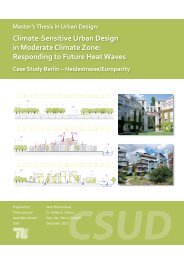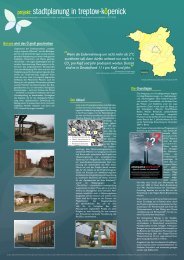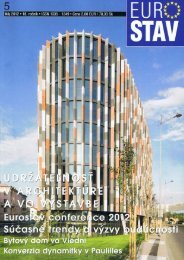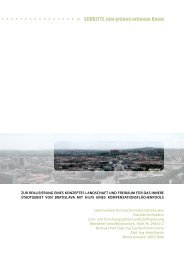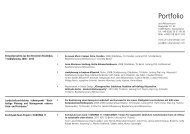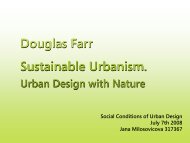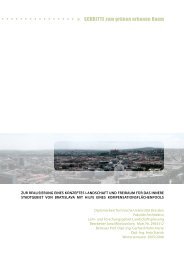Bausteine - Referate - Jana Milosovicova - Urban Design English
Bausteine - Referate - Jana Milosovicova - Urban Design English
Bausteine - Referate - Jana Milosovicova - Urban Design English
Erfolgreiche ePaper selbst erstellen
Machen Sie aus Ihren PDF Publikationen ein blätterbares Flipbook mit unserer einzigartigen Google optimierten e-Paper Software.
Sustainable neighborhood rating systems: An international comparison<br />
Die Bewertungsmatrix<br />
for at least half of the residents and businesses,<br />
offering up to four points for 10 diverse uses.<br />
The Assessment Matrix evaluates the access to<br />
“daily needed goods,” giving the highest score to<br />
a place where they are within walking distance<br />
and a mid-level score when they are within a<br />
10 minute bicycle or transit journey. LEED-ND’s<br />
“diverse uses” list has some services which are<br />
also considered “daily needed goods” in the<br />
Assessment Matrix such as a bank, pharmacy,<br />
restaurant and supermarket. (See Table 2 for<br />
a complete comparison.) However, the LEED-<br />
ND “diverse uses” list includes less frequented<br />
services such as a theater, a hardware store and<br />
a police/fire station. In the Assessment Matrix,<br />
the first two are considered appropriate for a<br />
neighborhood center location; the third is not<br />
addressed.<br />
It should be noted: German planning regulations<br />
use the standard of “daily needed goods,”<br />
specifying them as conditional uses in restricted<br />
residential zones and permitted uses in general<br />
residential and mixed-use zones. (See Table<br />
1 for a comparison of residential zoning.) The<br />
small scale retail allowed in general residential or<br />
mixed-use areas has a size limit of 1,200 square<br />
meters (13,000 square feet). However, German<br />
businesses have adapted to this scale of retail,<br />
from national chains to local businesses. While<br />
the determination of a “daily needed good” is at<br />
the discretion of a local planner, the application<br />
of it is not considered problematic – they are<br />
considered to be shops or services that most<br />
Germans frequent at least once per week.<br />
Access to Social Infrastructure<br />
and Cultural Offerings<br />
LEED-ND has a credit for providing a school<br />
within a ½ mile (400 meter) walk for at least<br />
half of the residents and considers day care as a<br />
“diverse use.” In the Assessment Matrix evaluation<br />
of social infrastructure, such as a school, day<br />
care and doctor, the best score is based on the<br />
ease of reachability and competitiveness of transit.<br />
The Assessment Matrix also has a separate<br />
category for cultural offerings such as a theater<br />
or museum, also measured by reachability and<br />
transit competitiveness. Once again, LEED-ND<br />
doesn’t differentiate cultural options but does<br />
include a theater with diverse uses.<br />
Access to Recreational Space<br />
For recreational space, LEED-ND offers credits<br />
for providing parks, squares, sports facilities or<br />
other recreational options within a 1/6-1/2 mile<br />
(130-400 meter), depending on the type of<br />
space. In the Assessment Matrix, the best score<br />
is given if there are at least two recreational<br />
options in close proximity; the score drops somewhat<br />
if recreational options can be reached<br />
within 10 minutes by bicycle or transit.<br />
3. Compact and Walkable <strong>Design</strong><br />
The Compact and Walkable <strong>Design</strong> category<br />
analyzes the density and urban design of a particular<br />
site. While both rating systems share the<br />
same goal of compact design with higher density,<br />
LEED-ND goes further in evaluating walkability.<br />
Density and Mixed-Use<br />
Common metrics are used to evaluate density:<br />
floor area ratio (FAR) and dwelling units (DU)<br />
per acre in LEED-ND an FAR and lot coverage<br />
ratio in the Assessment Matrix. LEED-ND has<br />
a prerequisite density of a 0.50 FAR for commercial<br />
buildings and 7 dwelling units per acre<br />
(2.8 units per hectare) for residential areas. This<br />
residential standard based on the minimum<br />
density to support basic bus service. (Pushkarev<br />
and Zupan 1977) This standard goes up to a<br />
3.5 FAR for commercial buildings or 70 dwelling<br />
unit per acre (2.8 units per hectare). The Assessment<br />
Matrix the best scores to residential<br />
areas with a lot coverage ratio of 60 percent<br />
and 1.8 FAR to mixed-use areas with an 80 percent<br />
lot coverage ratio and 2.4 FAR. The density<br />
standard is higher in LEED-ND, with a FAR of<br />
1.8 given the best rating for residential in the<br />
Assessment Matrix, yet it only scores three out<br />
106



